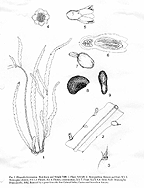
- Stems - more or less erect, with the longest
ones finally sprawling-pendent, to 80 cm ( - 2 m) tall or more, branching
basally and laterally, 2 - sided, with age becoming terete near base,
(1.5 -) 2.5 - 3.5 cm wide, 3 - 5 mm thick through midrib, elsewhere
ca. 1.5 mm thick, the apices obtuse, the stem margins undulate, crenate,
the lobes protruding 2 - 4 mm; epidermis smooth, light green, rather
dull.
- Areoles
- ca. 2 cm (5 - 30 mm) apart, at bottom of
sinus between lobes, the leaflets appressed to areoles and folded around
stem-edges, broadly truncate, ca. 2 mm wide and 1 mm long, auriculate
on either side near base, with a slight erose margin. whitish and translucent,
the areole with dense, curly, yellowish wool less than 1 mm long and 2
- 3 (1 - 8) subulate, sharp, straight, erect spines 1 - 1.5 mm long, these
at first cream, later brownish.
- Flowers -
single at an areole. narrowly campanulate, ca. 10 mm long, the tepals
more or less straight and diverging at ca. 45 degrees, the limb 4 -
5 mm wide.
- Receptacle - 4 - 5 mm long, oblong, 3 - 3.5 mm thick at middle, 2.5 - 3 mm thick
at apex, yellowish green, smooth, shiny, with 3 - 5 obscure, very obtuse
podaria.
- Bracteoles -
widely ovate to sub-deltoid, obtuse to subacute, often somewhat serrate,
yellowish green, more yellow and translucent near margin, to 0.5 mm
long and 0.75 mm wide, rather fleshy, not subtending wool, hairs or
spines.
- Outer tepals - 8 - 10, the lowest oblong, the upper becoming more oblanceolate, obtuse,
the outer face convex, the inner concave, 2 - 6 mm long, 1.5-2 mm wide,
the lower ones greenish cream, the upper ones more yellowish.
- Inner tepals - 6 or 7, linear-oblong, obtuse, 5-6 mm long, ca. 2 mm wide at middle,
faintly greenish cream; ovule-chamber turbinate, 2 mm long and 1 mm
wide.
- Nectaries - ca. 0.75 mm long.
- Stamens - inserted in a single zone at apex of nectaries, the filaments 2.5 -
3 mm long, ca. 0.15 mm wide, yellowish cream, the anthers broadly renate
to oblong, ca. 0.33 mm in diameter, yellowish.
- Style -
4-4.25 mm long and 0.5 mm thick, yellowish, the stigma lobes 4 or 5,
widely expanding, oblong-ovate, ca. 1 mm long and 0.33 mm thick, heavily
papillose, cream.
- Fruit - oblong, 6 - 8 mm long excluding dried perianth, 5 - 7 mm thick, the
epidermis at first light green, finally whitish and translucent, with
the seeds and white venation visible within, smooth and shiny, the bracteoles
appressed, deltoid. less than 1 mm long and wide, greenish, lacking
areolar wool; pulp colorless; dried perianth straight. ca. 3 mm long,
brownish.
- Seeds - ovoid, 1.25-1.50 mm long, 0.75-1 mm wide, ca. 0.5 mm thick. the testa
slightly and obtusely ridged along edge opposite hilum, smoother elsewhere,
shiny, dark brown, the hilum diverging 45 degrees from main seed-axis,
hardly depressed, whitish.
PERU: Dept. Amazonas: Prov. Chachapoyas: Cerro Calla
Calla, 42 km below summit and ca. 21 km above Balsas, at Km 360.5,
1900 m alt., Oct.16, 1964, Hutchison & Wright 7006. UCBG 64.1726,
HBG 18379 (F, NY, UC, US, USM); same collection pressed in cultivation
(HNT)
DISTRIBUTION - Peru (Amazonas, Junin?); terrestrial,
at c. 1700 - 2000 m altitude.
This species remains poorly known and is only provisionally
placed in this genus on the basis of its whitish translucent, veined,
mature fruits. Its Peruvian type locality is remote from other Lepismium
taxa, although a recent collection from Depto Junin (Smith and Palacios
2646, SI!), which is only provisionally placed here ( cf. also species
L. paranganiense and L. bolivianum; fruits described
as pinkish cream), may provide a geographical link with its congeners
to the south.
Even though Ritter deposited a specimen of this taxon
at the University of Utrecht Herbarium (U!), his name Acanthorhipsalis
brevispina is invalid, since he failed to cite this specimen in
the protologue (cf. ICBN Art.37.3).
Previous Page
|